Chief of the Air Staff (United Kingdom)
| Chief of the Air Staff (CAS) | |
|---|---|
|
Ensign of the Royal Air Force (CAS Command Flag) | |
| Ministry of Defence | |
| Style | Air Chief Marshal |
| Member of |
Defence Council Air Force Board |
| Reports to | Chief of the Defence Staff |
| Nominator | Secretary of State for Defence |
| Appointer |
Prime Minister Subject to formal approval by the Queen-in-Council[1] |
| Inaugural holder |
Major-General Sir Hugh Trenchard |
| Website | raf.mod.uk |
The Chief of the Air Staff (CAS) is the professional head of the Royal Air Force and a member of both the Chiefs of Staff Committee and the Air Force Board. The post was created in 1918 with Major-General Sir Hugh Trenchard as the first incumbent. The current and 31st Chief of the Air Staff is Air Chief Marshal Sir Stephen Hillier, who succeeded Sir Andrew Pulford in July 2016.[2][3]
History
The post was established in January 1918, just prior to the official formation of the RAF, and its first occupant was Major-General Sir Hugh Trenchard. Following Trenchard's resignation in March 1918 after disagreements with the first air minister, his rival Major-General Sir Frederick Sykes was appointed. For political reasons Trenchard's resignation did not take effect until late April in order that he would be CAS when the RAF was formed. With Churchill's post-War appointment as Secretary of State for War and Air, Sykes was moved sideways to head up the nascent Civil Aviation ministry and Trenchard returned as Chief of the Air Staff. In the early 1920s Trenchard had to fight to keep the RAF from being divided and being absorbed back into the Royal Navy and the British Army. After Lord Trenchard retired in 1930 there were still suggestions that the RAF should be broken up, but Trenchard's foundations proved solid.[4]
By the time World War II broke out in 1939, the then occupant of the post, Air Chief Marshal Sir Cyril Newall, had a service that had been undergoing the most rapid of expansions during the British rearmament programs of the late 1930s. Newall gave way in 1940 to Air Chief Marshal Sir Charles Portal, who led the service for the rest of the war. Portal was a tireless defender of the RAF and extremely able in administration and strategy. Postwar the RAF was reoriented to perform the dual roles of defending the shrinking British Empire and possibly fighting against the Soviet Union in a Warsaw Pact verses NATO war over Germany and the United Kingdom. The Chiefs of the Air Staff of the day had to fight a constant battle to keep the British aircraft industry alive. In the end only minimal success was achieved, with only a rump aviation industrial base left by the 1970s.[5]
The first eight chiefs of the air staff were originally commissioned in the Army, with four coming from the infantry, two from the artillery and one each from the cavalry and the engineers. Of these both Lord Trenchard and Sir John Salmond each held the post over two separate periods. By the early mid-1950s sufficient time had elapsed for officers originally commissioned in the British air services of World War I to have risen through the ranks to RAF's senior post; Sir John Slessor had originally served in the Royal Flying Corps while Sir William Dickson was commissioned into the Royal Naval Air Service. In 1956 Sir Dermot Boyle became the first chief to have originally been commissioned in the RAF.[6]
Chiefs of the Air Staff
The following list gives details of the chiefs of the air staff from 1918 to the present:
| Ordinal | Image | Date of appointment | Rank | Incumbent | Flying specialism or arm | References |
|---|---|---|---|---|---|---|
| 1st | 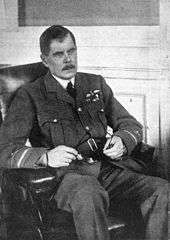 | 3 January 1918 | Major-General | Sir Hugh Trenchard | Infantry | [7] |
| 2nd | 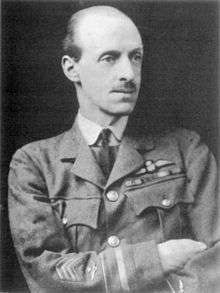 | 13 April 1918 | Major-General | Sir Frederick Sykes | Cavalry | [8] |
| 3rd | .jpg) | 31 March 1919 | Marshal of the Royal Air Force | Sir Hugh Trenchard | Infantry | [9] |
| 4th | 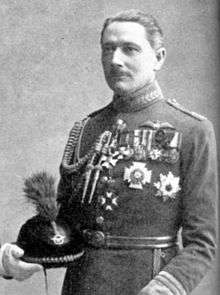 | 1 January 1930 | Air Chief Marshal | Sir John Salmond | Infantry | [10] |
| 5th | 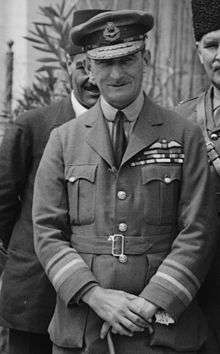 | 1 April 1933 | Air Chief Marshal | Sir Geoffrey Salmond | Artillery | [11] |
| 6th |  | 28 April 1933 | Marshal of the Royal Air Force | Sir John Salmond | Infantry | [12] |
| 7th |  | 22 May 1933 | Marshal of the Royal Air Force | Sir Edward Ellington | Artillery | [13] |
| 8th | .jpg) | 1 September 1937 | Marshal of the Royal Air Force | Sir Cyril Newall | Infantry | [14] |
| 9th | 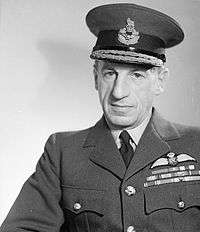 | 25 October 1940 | Marshal of the Royal Air Force | The Lord Portal | Engineers | [15] |
| 10th |  | 1 January 1946 | Marshal of the Royal Air Force | Sir Arthur Tedder | Infantry | [16] |
| 11th | 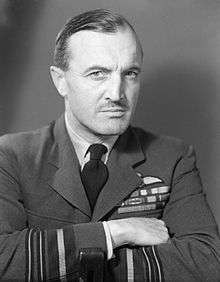 | 1 January 1950 | Marshal of the Royal Air Force | Sir John Slessor | Fighters (biplanes) | [17] |
| 12th | .jpg) | 1 January 1953 | Marshal of the Royal Air Force | Sir William Dickson | Naval aviation (biplanes) | [18] |
| 13th |  | 1 January 1956 | Marshal of the Royal Air Force | Sir Dermot Boyle | Fighters (biplanes) | [19] |
| 14th |  | 1 January 1960 | Marshal of the Royal Air Force | Sir Thomas Pike | Fighters (biplanes) | [20] |
| 15th | 1 September 1963 | Air Chief Marshal | Sir Charles Elworthy | Bombers (biplanes) | [21] | |
| 16th | 1 April 1967 | Air Chief Marshal | Sir John Grandy | Fighters (biplanes) | [22] | |
| 17th | 1 April 1971 | Air Chief Marshal | Sir Denis Spotswood | Multirole (monoplane) | [23] | |
| 18th | 1 April 1974 | Air Chief Marshal | Sir Andrew Humphrey | Fighters (monoplane) | [24] | |
| 19th | 7 August 1976 | Marshal of the Royal Air Force | Sir Neil Cameron | Fighters (monoplane) | [25] | |
| 20th |  | 10 August 1977 | Air Chief Marshal | Sir Michael Beetham | Bombers (monoplane) | [26] |
| 21st | 15 October 1982 | Air Chief Marshal | Sir Keith Williamson | Fighters (fast jet) | [27] | |
| 22nd | 15 October 1985 | Air Chief Marshal | Sir David Craig | Fighters (fast jet) | [28] | |
| 23rd | 14 November 1988 | Air Chief Marshal | Sir Peter Harding | Bombers (jet) | [29] | |
| 24th | 6 November 1992 | Air Chief Marshal | Sir Michael Graydon | Fighters (fast jet) | [30] | |
| 25th | .jpg) | 10 April 1997 | Air Chief Marshal | Sir Richard Johns | Fighters (fast jet) | [31] |
| 26th | 21 April 2000 | Air Chief Marshal | Sir Peter Squire | Fighters (fast jet) | [32] | |
| 27th |  | 1 August 2003 | Air Chief Marshal | Sir Jock Stirrup | Ground attack / reconnaissance (fast jet) | [33] |
| 28th | .jpg) | 13 April 2006 | Air Chief Marshal | Sir Glenn Torpy | Ground attack (fast jet) | [34] |
| 29th |  | 31 July 2009 | Air Chief Marshal | Sir Stephen Dalton | Ground attack (fast jet) | [35] |
| 30th |  | 31 July 2013 | Air Chief Marshal | Sir Andrew Pulford | Helicopters | [36] |
| 31st | 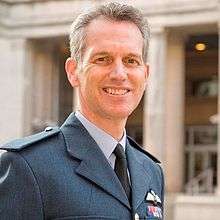 | 11 July 2016 | Air Chief Marshal | Sir Stephen Hillier | Ground attack (fast jet) | [37] |
- ^ The ranks shown are the highest rank that the officer in question attained during his tour as Chief of the Air Staff. However, in the case where the officer was promoted on the day before he was posted or retired, then the lower rank is shown.
See also
Other service chiefs
- Chief of the Defence Staff (United Kingdom)
- First Sea Lord / Chief of the Naval Staff
- Chief of the General Staff (United Kingdom)
- Chief of Air Force (Australia) (Between 1922 and 1997, the RAAF's senior officer was known as "Chief of the Air Staff".)
- Chief of the Air Staff (disambiguation)
Generally relevant
References
- ↑ Departmental Resource Accounts 2006-7 Ministry of Defence
- ↑ "The Secretary of State announces new Senior Appointments in the Armed Services". Retrieved 15 April 2016.
- ↑ "Chief of the Air Staff (CAS) Sir Stephen Hillier". Royal Air Force. Retrieved 12 June 2016.
- ↑ "Sir John Salmond". Oxford Dictionary of National Biography. Retrieved 2 August 2012.
- ↑ "Meeting our makers: Britain's long industrial decline". New Statesman. 24 January 2013. Retrieved 1 October 2014.
- ↑ "Sir Dermot Alexander Boyle". Oxford Dictionary of National Biography. Retrieved 14 July 2012.
- ↑ Barrass, Malcolm (9 October 2007). "Marshal of the RAF The Viscount Trenchard of Wolfeton". Air of Authority - A History of RAF Organisation. Retrieved 25 May 2009.
- ↑ "Air Vice Marshal Sir Frederick Sykes". Air of Authority - A History of RAF Organisation. Retrieved 5 August 2012.
- ↑ The London Gazette: no. 31348. p. 6249. 20 May 1919. Retrieved 25 May 2009.
- ↑ The London Gazette: no. 33565. p. 8506. 31 December 1929. Retrieved 25 May 2009.
- ↑ The London Gazette: (Supplement) no. 33926. p. 2194. 31 March 1933. Retrieved 5 August 2012.
- ↑ The London Gazette: no. 33936. p. 2940. 2 May 1933. Retrieved 2 August 2012.
- ↑ The London Gazette: no. 33942. p. 3457. 23 May 1933. Retrieved 1 August 2012.
- ↑ The London Gazette: no. 34432. p. 5561. 3 September 1937. Retrieved 30 July 2012.
- ↑ The London Gazette: (Supplement) no. 34989. p. 6492. 12 November 1940. Retrieved 29 July 2012.
- ↑ "Marshal of the Royal Air Force Lord Tedder". Air of Authority: A History of RAF Organisation. Retrieved 22 July 2012.
- ↑ The London Gazette: (Supplement) no. 38795. p. 6168. 30 December 1949. Retrieved 21 July 2012.
- ↑ The London Gazette: (Supplement) no. 39739. p. 56. 30 December 1952. Retrieved 21 July 2012.
- ↑ The London Gazette: (Supplement) no. 40666. p. 7307. 27 December 1955. Retrieved 14 July 2012.
- ↑ The London Gazette: (Supplement) no. 41664. p. 1979. 20 March 1959. Retrieved 14 July 2012.
- ↑ The London Gazette: (Supplement) no. 42924. p. 1615. 15 February 1963. Retrieved 8 July 2012.
- ↑ The London Gazette: (Supplement) no. 44281. p. 3691. 31 March 1967. Retrieved 10 June 2012.
- ↑ The London Gazette: (Supplement) no. 45337. p. 3340. 5 April 1971. Retrieved 9 June 2012.
- ↑ The London Gazette: (Supplement) no. 46252. p. 4287. 1 April 1974. Retrieved 6 June 2012.
- ↑ The London Gazette: (Supplement) no. 46984. p. 10916. 10 August 1976. Retrieved 5 June 2012.
- ↑ The London Gazette: (Supplement) no. 47289. p. 9978. 1 August 1977. Retrieved 10 June 2012.
- ↑ The London Gazette: (Supplement) no. 49156. p. 14275. 1 November 1982. Retrieved 3 June 2012.
- ↑ The London Gazette: (Supplement) no. 50279. p. 13878. 7 October 1985. Retrieved 3 June 2012.
- ↑ The London Gazette: (Supplement) no. 51543. p. 13394. 28 November 1988. Retrieved 2 June 2012.
- ↑ "Sir Michael Graydon". Debretts People of Today. Retrieved 1 October 2014.
- ↑ "Sir Richard Johns". Debretts People of Today. Retrieved 1 October 2014.
- ↑ Who's Who 2010, A & C Black, 2010, ISBN 978-1-4081-1414-8
- ↑ "Sir Jock Stirrup". NATO. Retrieved 20 May 2012.
- ↑ The London Gazette: (Supplement) no. 57965. p. 5686. 25 April 2006. Retrieved 5 February 2012.
- ↑ "Air Rank Appointments List 07/08 dated 16 October 2008". Ministry of Defence. Retrieved 26 May 2012.
- ↑ The London Gazette: (Supplement) no. 60575. p. 14490. 23 July 2013. Retrieved 1 October 2014.
- ↑ The London Gazette: (Supplement) no. 61656. p. 16088. 26 July 2016. Retrieved 3 December 2016.
